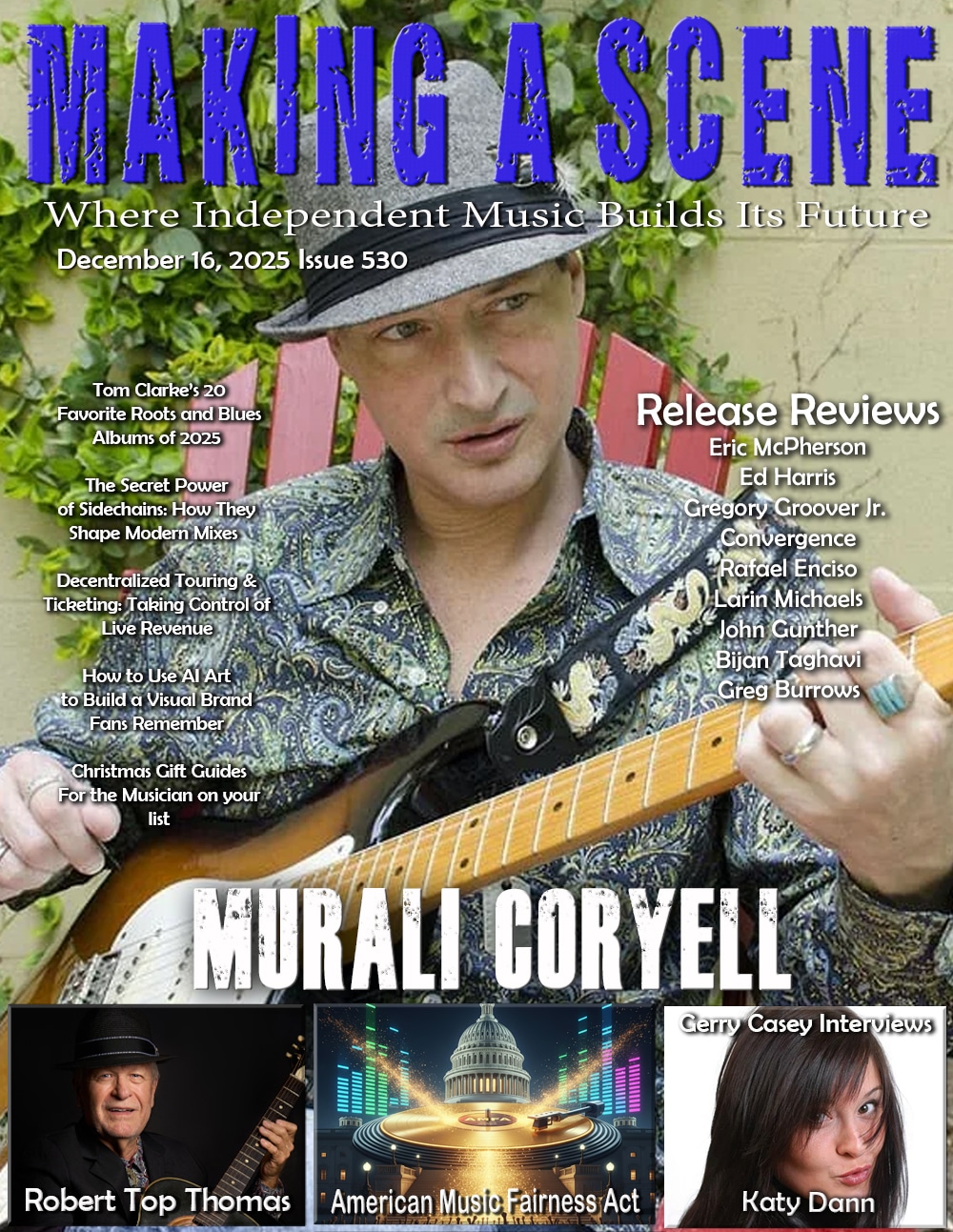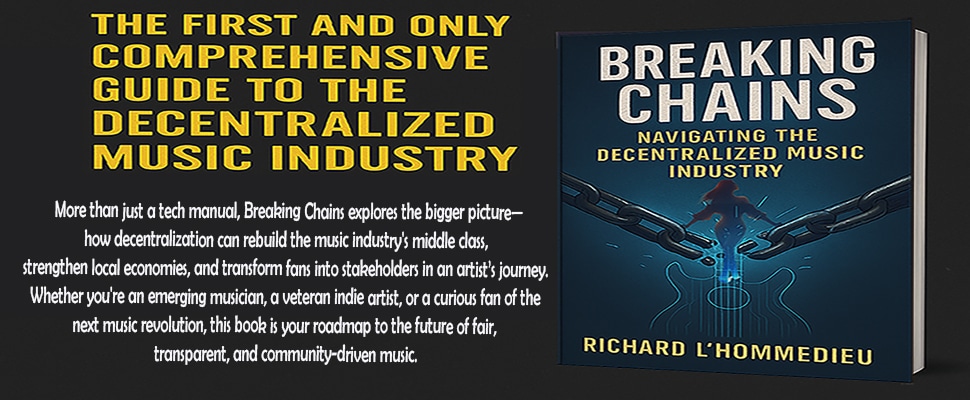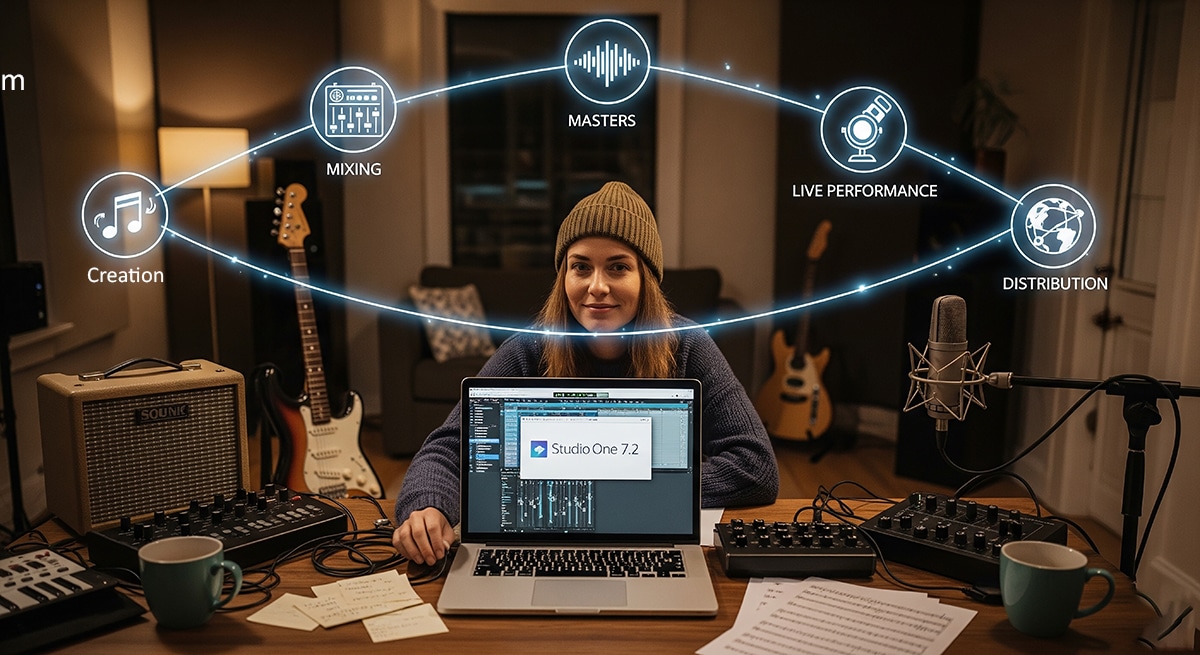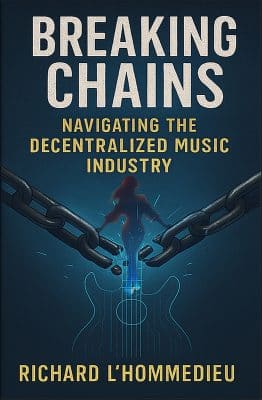PreSonus Studio One 7.2 — A Deep Dive Review
Making a Scene Presents PreSonus Studio One 7.2 — A Deep Dive Review
If you want a DAW that feels fast, flexible, and seriously pro, Studio One 7.2 hits that sweet spot. It’s built for songwriters, beat-makers, mixing engineers, and mastering folks who want one home for everything. In this review, I’ll walk you through what Studio One 7.2 adds on top of the already strong Studio One 7 base, explain how the AI features actually help real sessions, and talk about why PreSonus being part of Fender matters for the future of the platform.
I’m keeping this in clear, simple language. Think of it like a friendly studio walkthrough, not a dry tech manual. We’ll go section by section, with a short highlight list here and there when it really helps.
A Brief History of Studio One
Studio One hasn’t been around as long as some of the “old guard” DAWs, but that’s actually its biggest advantage. Back in the mid-2000s, a group of ex-Steinberg engineers—people who had worked on Cubase and Nuendo—teamed up with Jim Odem’s PreSonus in Baton Rouge, LA. They didn’t want to patch up old code or pile features onto outdated menus. They wanted a fresh start. In 2009, Studio One 1.0 hit the scene with a single-window interface and drag-and-drop workflow that felt like a breath of fresh air compared to the clunky giants of the day.
It didn’t take long for Studio One to grow up. By version 2, it had integrated mastering with the Project Page and was the first DAW to bring in Melodyne through ARA integration—a game-changer at the time. Version 3 and 4 made it just as appealing for songwriters as engineers, adding scratch pads, arranger tracks, chord tracks, and pattern editors so you could mess with structure and harmony without tearing your session apart.
Then came version 5 in 2020, which really cemented Studio One as an all-in-one solution. Suddenly you could record, mix, master, and even take your songs on stage with Show mode. No bouncing between apps, no duct-taping a workflow together—it all lived inside one DAW.
Things shifted again in 2021 when Fender bought PreSonus. That was a big move, because it tied the biggest guitar company in the world to one of the most forward-thinking DAWs. Since then, Studio One has been sprinting. Version 6 doubled down on customization and even added a video track. Version 7 brought the Launcher for clip-based workflows, AI stem separation, Splice integration, and Dolby Atmos support. And now, with 7.2, we’ve got new instruments like Sub Zero Bass, Nashville Number notation, smarter punch recording, and a ton of small fixes that make everyday work smoother.
Studio One may not have the decades of baggage that Pro Tools or Logic carry, and that’s the point. From day one, it’s been designed to be fast, modern, and complete—a DAW that keeps pace with how musicians actually work today.
The Big Picture: What Studio One Is (and Why People Stick With It)
Studio One has always been about speed: drag-and-drop instruments and effects, a clean mixer, smart editing tools, and tight integration with mastering and even live shows inside the same app. With version 7, PreSonus added major modern workflows: a clip-based Launcher for loops and ideas, AI-powered stem separation, Splice sample integration, Dolby Atmos mixing/rendering, and Apple Spatial Audio monitoring support—plus a healthy pile of new instruments and editor upgrades. That foundation is why 7.2 feels like a grown, professional environment rather than a patchwork of add-ons.
What’s New in Studio One 7.2 (June 2025 Update)
Version 7.2 isn’t just bug fixes. It brings musical and workflow upgrades that touch writing, editing, and session management.
New creative tools
-
Sub Zero Bass (new virtual instrument): A dedicated low-end instrument for thick, punchy bass parts. It’s built right into Studio One 7.2, so you don’t need a third-party plug-in to get modern bass sounds fast.
-
Tuner2 with open tunings: The updated tuner now supports open tunings—handy for guitarists and string players working outside standard EADGBE. It’s simple, visible, and ready for alternate tunings without jumping to another tool.
-
Nashville Number System view: If you write with chords, this is gold. You can flip chord display to the Nashville numbers (1, 4, 5, etc.) instead of letter names. That makes key changes painless and helps bands communicate quickly.
Recording & editing polish
-
Post-roll for Auto Punch (loop recording): Auto-punching feels better when the player hears a little extra after the punch point. Post-roll keeps takes tight and musical.
-
Continuous cursor options & improved score sync: These tweaks keep your eyes and brain glued to the music instead of fighting the timeline. You can choose how the playhead behaves and trust the score view to stay aligned.
Mixing & session management
-
Better “real-time” vs “offline” export behavior: More reliable bounces and fewer surprises when printing mixes or stems.
-
Plug-in management improvements and automation target search: Faster to find, sort, and automate what you need without scrolling through long lists or nested menus.
Quality-of-life UI touches
-
Auto Zoom for Patterns, clearer distinction of Pattern Parts, and improved range selection visibility: Step programming and editing just read better on screen, which makes you faster.
Performance & platform updates
-
Apple Silicon multi-processing improvements and Windows on Arm support (public beta): The engine gets leaner and meaner on modern chips.
-
Notifications for new downloadable sound content: The DAW taps you on the shoulder when there’s new stuff you might want to add.
If you love reading the nitty-gritty, PreSonus’ 7.2 release notes go deep on fixes and changes across Ampire, ARA, Launcher, Score, and more. It’s a long list—and that’s a good sign for a DAW you rely on every day.
The AI Angle: Where Studio One Uses It (and why it’s actually useful)
Let’s cut through the buzz: Studio One’s headline AI feature is AI-powered stem separation. Drop in a stereo mix, and the DAW can “un-mix” it into Drums, Bass, Vocals, and Other (offline process, so you’re not waiting on the cloud). Use it to build clean remixes, grab a capellas for creative transitions, study parts for learning, or fix arrangement problems when you don’t have the original multitracks. It’s practical, not hype.
Where this shines in real life:
-
You’re producing a remix and the artist only sent you a stereo master. Stem separation gives you workable drums and vocals so you can craft drops and builds without fighting the whole mix.
-
You’re a bandleader who needs a minus-vocals mix for rehearsals or a karaoke-style track for a one-off show.
-
You’re a teacher showing how arrangement layers interact. Being able to solo “bass” or “drums” from a finished track makes those lessons click.
This is the kind of AI musicians actually use because it’s tied to a clear outcome: better control over music you already have. And since Studio One’s broader toolkit (Launcher, Clip Editing, Impact, Note Editor) is built around non-destructive, fast edits, the AI stem pieces slot right into the existing flow.
Workflow Superpowers You Feel Every Day
Even if you never touch stems, Studio One 7 (and now 7.2) nails the fundamentals that pros care about:
The Launcher: ideas without friction
Studio One’s Launcher gives you a clip-based workflow inside the same timeline where you track bands and mix. You can jam scenes, capture loops, and then drop the good stuff into a traditional arrangement. No exporting between two different apps. It’s a best-of-both-worlds approach that fits songwriting, beat sessions, and live production.
Tight content pipeline: Splice, drag, done
With native Splice integration, auditioning and dropping samples is faster. Your key/BPM context comes across, and it lives right in the Browser. That shaves minutes off every idea you try.
Editing that respects music, not just audio
The Scale Panel, user scales, filter notes to scale, and hide unused pitches are small features that make MIDI editing feel musical. Pair that with Global Transpose and the new Nashville Number view, and changing keys or reharmonizing doesn’t turn into a mess.
Painless sound design and hybrid setups
Studio One includes a serious instrument bench: Deep Flight One, Presence, Lead Architect, and now Sub Zero Bass, plus Impact and Sample One workflow upgrades. There’s also a CV Instrument for driving modular or semi-modular hardware, so hybrid rigs are fair game.
Mixing for the formats that pay
Integrated Dolby Atmos mixing/rendering and Apple Spatial Audio monitoring let you deliver in immersive formats without duct-taping third-party tools. If you work with labels or want to pitch to modern placements, this matters.
One app from demo to master
Studio One’s long-standing “Song → Project → Show” concept means you can record, mix, master (with DDP, loudness metering, etc.), and take your set on stage—without bouncing between separate programs. That’s not fluff; it’s fewer chances to break something right before a deadline.
How 7.2 Changes Day-to-Day Sessions
Here’s how the new pieces actually help, beyond the bullet points:
-
Writing with Nashville Numbers: If you’re co-writing or cutting tracks with a band, you can write the chart once and try key changes instantly. No one argues about transposing chords; the numbers stay the same. That speeds up sessions and reduces mistakes when you go to record takes.
-
Post-roll Auto Punch: Singers and players often tighten up when they hear context after the punch point. It makes comping cleaner because the takes feel natural, not chopped. If you do a lot of looped overdubs, you’ll notice the difference on day one.
-
Tuner2 with open tunings: Roots, blues, Americana, and modern indie love alternate tunings. Having the DAW recognize that directly means fewer trips to a pedal or phone app and fewer “wait, is that right?” moments before a take.
-
Automation search + plug-in management: Big mixes aren’t scary when you can type the parameter you want to automate and jump straight there. Organization is a major time-saver on tight deadlines.
-
Performance updates (Apple Silicon, Windows on Arm): Lower CPU spikes and better multi-processing mean more headroom for hungry instruments and immersive mixes. Your laptop simply behaves more like a studio tower.
Power Features That Make It “Pro”
Studio One 7.2 isn’t just “easy.” It’s deep where it counts:
-
Unlimited tracks, buses, FX channels, and plug-ins (your machine is the limit). That matters for film cues, live stems, and complicated hybrid sessions.
-
CLAP support for modern plug-ins, ARA integration for Melodyne-style editing, Audio Batch Converter, and improved tempo detection. These aren’t flashy, but they’re the plumbing that keeps complex projects moving.
-
Integrated distribution (TuneCore/SoundCloud) and Studio One Pro+ content pipeline if you’re on the subscription. It’s not replacing your marketing plan, but it’s one less set of logins and exports.
-
Smart Templates that set up full workflows (recording, mixing, mastering, beat production) from the Start Page. These aren’t toy presets; they pre-wire useful routings so you can actually start.
Sound & Instruments: “Sub Zero Bass” and Friends
The star of 7.2’s sound additions is Sub Zero Bass. If you produce modern rock, pop, hip-hop, or electronic, you know that “the bass has to sit right” is 80% of the fight. Sub Zero Bass gives you thick, focused tones that are mix-ready without hours of stacking plug-ins. Combine it with the Scale tools to lock in bass lines without clashing notes, and you’ll build low-end foundations faster.
On top of that, Studio One 7 already delivered Deep Flight One (cinematic textures) and earlier 7.1 added Cinematic Lights—both geared toward vibe and mood without chasing third-party libraries right away. You can sketch full cues and then decide later which sounds to swap for your favorite external instruments.
Editing & MIDI: Music-First Tools That Don’t Get in the Way
The reason many writers stick with Studio One is the way editing feels musical. Little things add up: hide notes you’re not using, filter to scale, or change per-step resolution in Patterns when you want micro-rhythms. In 7.2, the Auto Zoom for Patterns and clearly marked Pattern Parts reduce the “where am I?” feeling so programming drums or arps is quick. The Continuous Cursor options also help you stay oriented during long takes or tight comping sessions.
For guitar folks and scoring fans, improved score synchronization means the notation view and the timeline are less likely to argue about what’s happening. That’s huge when you’re exporting parts for real players or checking voicings.
Mixing & Delivery: Ready for Modern Formats
We can’t ignore where the industry is going. Labels and platforms want immersive formats. Studio One’s integrated Dolby Atmos mix and render tools, plus Apple Spatial Audio monitoring support, let you deliver without bolting on a separate pipeline. For indie artists, it’s a competitive edge; for post folks, it shortens the path to approvals. Pair that with the 7.2 export improvements, and you’re not babysitting bounces.
Stability & Trust: Release Notes That Actually Mean Something
The 7.x cycle has been busy, with 7.0 → 7.0.1 → 7.0.2 → 7.1 → 7.1.1 → 7.2 (and minor hotfixes like 7.2.2). Each step brought fixes across ARA, the Browser, the Launcher, Score Editor, plug-in behavior, and more. That pace matters: it tells you the dev team is in the trenches with users, tightening the screws where it counts. If you care about dependable sessions—especially live or broadcast—this is the kind of version history you want to see.
PreSonus + Fender: Why This Corporate Detail Actually Matters
In late 2021, Fender Musical Instruments Corporation (FMIC) announced it would acquire PreSonus. That merger put one of the biggest instrument brands under the same roof as a major DAW and a wide line of interfaces, mixers, and studio tools.
What could that mean for Studio One’s future?
-
Hardware/Software ecosystems that just click: Expect deeper pairing between Fender/PreSonus hardware (interfaces, modelers, amps, controllers) and Studio One templates, device control, and tone workflows. We’re already seeing ongoing PreSonus hardware news roll out under the Fender umbrella. The long-term play is clear: plug in and go, with less configuration time.
-
Guitar-first workflows: With Tuner2 adding open tunings and Studio One already strong with Ampire and guitar-friendly editing, it’s not a stretch to imagine richer tone libraries, Fender-voiced presets, and better “record a great guitar track in two clicks” experiences. That’s speculation—but the building blocks are visible in the update cadence and feature direction.
-
Distribution and creator tools: Fender has a massive education and creator footprint. Studio One’s integrated distribution hooks suggest more “from idea to fans” pipelines could show up—more templates, maybe artist-branded content packs, and tighter links between making music and releasing it.
Bottom line: corporate mergers don’t automatically make software better—but in this case, the incentives line up. Musicians want fewer hassles between guitar, interface, DAW, and release. Fender + PreSonus is positioned to deliver exactly that.
Where Studio One 7.2 Shines (and Where It’s Still Growing)
Shines
-
Speed: Drag-and-drop, an organized Browser, and Smart Templates make this DAW feel like home quickly.
-
Modern workflows: Launcher + AI stems + Splice + Atmos/Spatial = a DAW that respects how people produce today.
-
Musical editing: Scale tools, Nashville Numbers, and clear pattern views keep you focused on the song, not the screen.
-
One-stop shop: Track, mix, master, and perform in one app; fewer export/import headaches.
Still growing
-
Third-party ecosystem expectations: CLAP/VST3/ARA support is strong, but any DAW lives or dies by how well it plays with your favorite tools. Keep your plug-ins updated and test big sessions before show day.
-
Immersive learning curve: Atmos and Spatial Audio are built in, but there’s still a learning curve for routing and deliverables if you’re new to it. The good news: Studio One makes it simpler than piecing together a DIY chain.
Should You Upgrade to 7.2?
If you’re already on Studio One 7, 7.2 is a no-brainer. The Nashville Numbers view alone is worth it for writers and session players; the Tuner2 open-tuning support is great for guitar folks; the post-roll punch makes overdubs friendlier; and the export/automation/plug-in management touches remove daily friction. Performance gains on Apple Silicon and early Windows on Arm support show the engine is being tuned for the hardware we’ll all be using for years.
If you’re coming from another DAW, here’s the honest take: Studio One combines Ableton-style idea play (Launcher) with classic linear tracking and a real mastering page. Add in AI stems and immersive formats, and you’ve got a platform that lets you grow and deliver. This isn’t “beginner software.” It’s a modern, pro DAW with thoughtful design.
Final Verdict
Studio One 7.2 doesn’t scream with flashy marketing. It does something better: it makes real sessions smoother. The new Sub Zero Bass instrument, Tuner2 with open tunings, Nashville Numbers, post-roll punching, and the behind-the-scenes export/automation/visual upgrades all add up to a DAW that respects your time. On top of the 7.0 foundation—Launcher, AI stem separation, Splice, Atmos/Spatial—you’ve got a complete, future-ready environment.
PreSonus sitting inside Fender is more than a logo change. It points to a future where your guitar, interface, and DAW feel like one system. For working artists and engineers, that’s the kind of “big company” move that can actually save hours and unlock better work.
PreSonus offers a unique pricing option for Studio One. If you buy a one-year subscription directly from them for $179.99 and then choose not to renew the following year, your Studio One Pro license automatically converts into a perpetual license for the version you already have. That means you’ll keep your current version forever at no extra cost. You won’t receive future updates, but you’ll always be able to use the version you paid for.
If you want a powerful, professional DAW that meets you where modern music is actually made—and helps you finish—Studio One 7.2 is absolutely worth your attention. You can get a FREE DEMO from Presonus Here!
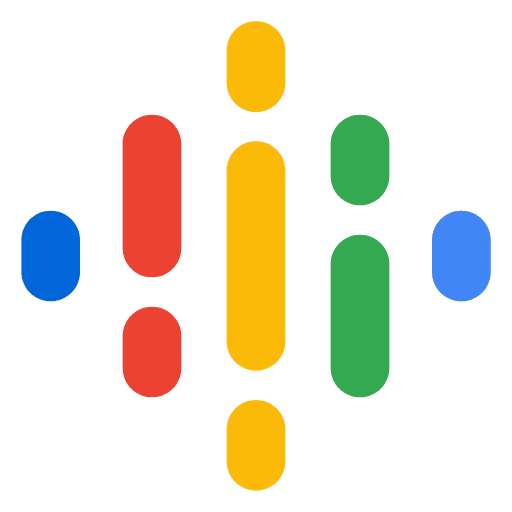 |  Spotify |  Deezer | Breaker |
 Pocket Cast |  Radio Public | 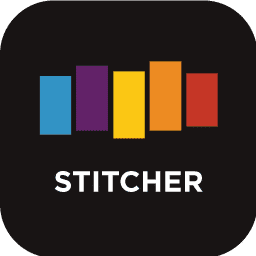 Stitcher | 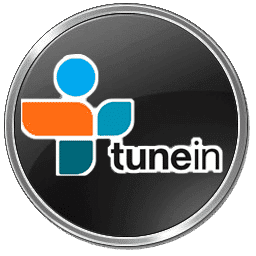 TuneIn |
 IHeart Radio |  Mixcloud |  PlayerFM |  Amazon |
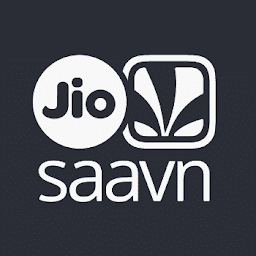 Jiosaavn |  Gaana | Vurbl | 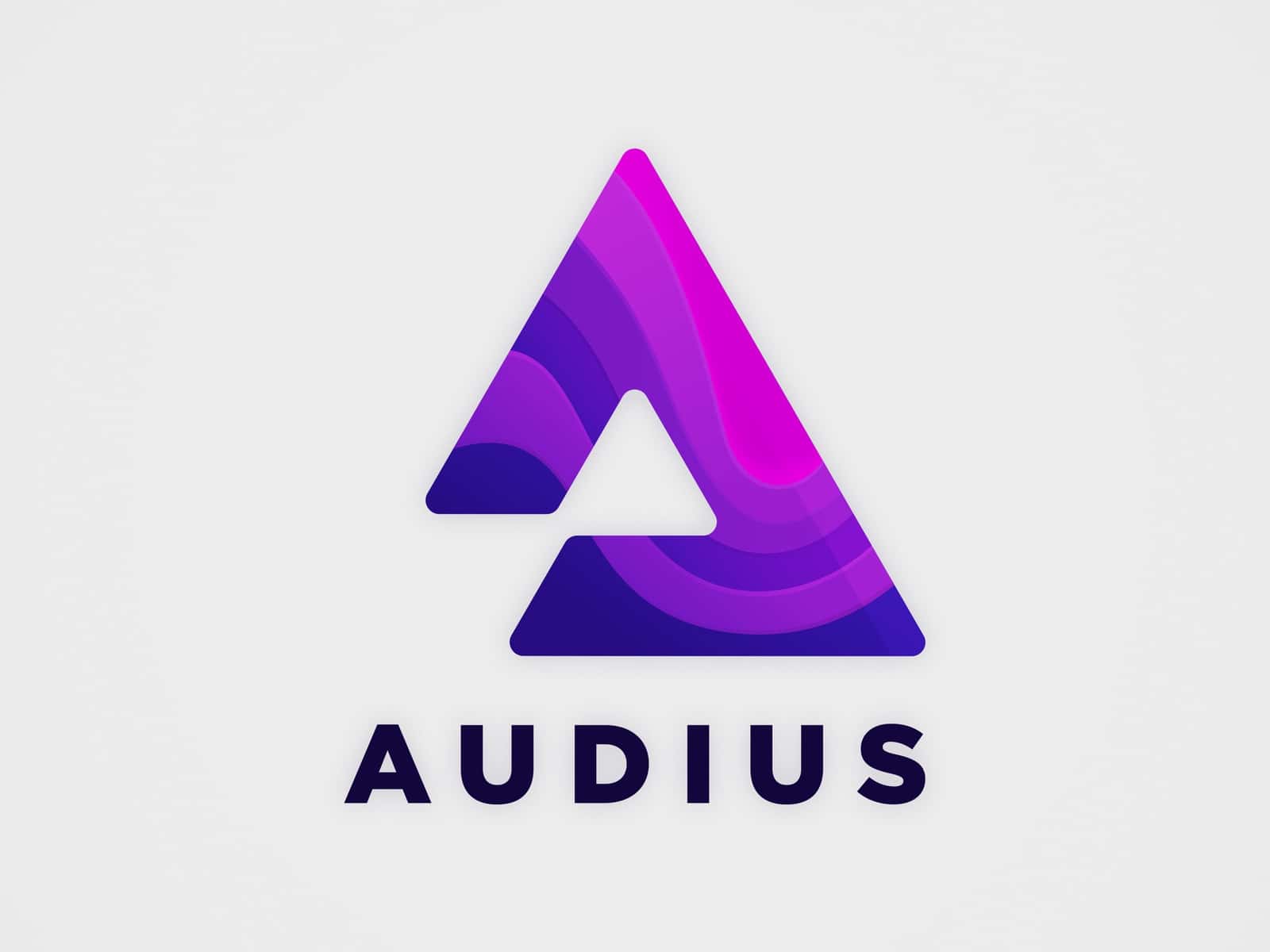 Audius |
Reason.Fm | |||
Find our Podcasts on these outlets
Buy Us a Cup of Coffee!
Join the movement in supporting Making a Scene, the premier independent resource for both emerging musicians and the dedicated fans who champion them.
We showcase this vibrant community that celebrates the raw talent and creative spirit driving the music industry forward. From insightful articles and in-depth interviews to exclusive content and insider tips, Making a Scene empowers artists to thrive and fans to discover their next favorite sound.
Together, let’s amplify the voices of independent musicians and forge unforgettable connections through the power of music
Make a one-time donation
Make a monthly donation
Make a yearly donation
Buy us a cup of Coffee!
Or enter a custom amount
Your contribution is appreciated.
Your contribution is appreciated.
Your contribution is appreciated.
DonateDonate monthlyDonate yearlyYou can donate directly through Paypal!
Subscribe to Our Newsletter
Order the New Book From Making a Scene
Breaking Chains – Navigating the Decentralized Music Industry
Breaking Chains is a groundbreaking guide for independent musicians ready to take control of their careers in the rapidly evolving world of decentralized music. From blockchain-powered royalties to NFTs, DAOs, and smart contracts, this book breaks down complex Web3 concepts into practical strategies that help artists earn more, connect directly with fans, and retain creative freedom. With real-world examples, platform recommendations, and step-by-step guidance, it empowers musicians to bypass traditional gatekeepers and build sustainable careers on their own terms.
More than just a tech manual, Breaking Chains explores the bigger picture—how decentralization can rebuild the music industry’s middle class, strengthen local economies, and transform fans into stakeholders in an artist’s journey. Whether you’re an emerging musician, a veteran indie artist, or a curious fan of the next music revolution, this book is your roadmap to the future of fair, transparent, and community-driven music.
Get your Limited Edition Signed and Numbered (Only 50 copies Available) Free Shipping Included
Discover more from Making A Scene!
Subscribe to get the latest posts sent to your email.
